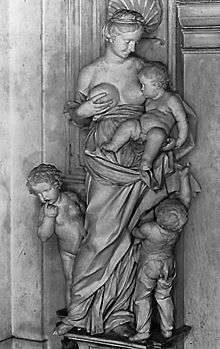Giacomo Serpotta

Giacomo Serpotta (10 March 1652 – 27 February 1732) was an Italian sculptor, active in a Rococo style and mainly working in stucco.
Serpotta was born and died in Palermo; and may have never left Sicily. His skill and facility with stucco sculpture appears to arise without mentorship or direct exposures to the mainstream of Italian Baroque. Rudolf Wittkower describes him as an aberrancy in an otherwise provincial scene, a "meteor in the Sicilian sky".
In 1677, along with Procopio de Ferrari, he decorated the small church of the Madonna dell’Itria in Monreale. His first independent work appears to be in 1682 in connection with an equestrian statue cast of Charles II of Spain and Sicily, which was cast in bronze by Gaspare Romano. The Serpotta family, including his brother Giuseppe (1653–1719) and his son Procopio (1679–1755), was immensely prolific, decorating the Oratory of San Lorenzo (1690/98–1706) with such a profusion of statuary, teeming with putti, that the walls appear to quiver with the movement of a crowd. He completed work also for the Oratory of Santa Cita (1668–1718), the Oratory of Rosario di San Domenico (1710–17), the chapel for the Ospedale di Palermo, the Archbishop's Palace in Santa Chiara, the Badia Nuova and the Church of SS. Cosma e Damiano in Alcamo. His work at the oratory of the Compagna della Carità di S Bartolomeo degli Incurabili in Palermo has been lost.
In style, he has a florid elegance that often recalls Antonio Raggi, a slightly older artist who was adept at stucco decoration and active in Rome.
Gallery
- Oratorio di Santa Cita, Palermo
- Oratorio di San Lorenzo, Palermo
- Oratorio di San Domenico Palermo
 Oratorio di San Domenico, c.1600.
Oratorio di San Domenico, c.1600.
Sources
| Wikimedia Commons has media related to Giacomo Serpotta. |
- Bruce Boucher (1998). Thames & Hudson, World of Art, ed. Italian Baroque Sculpture. pp. 184–185.
- Wittkower, Rudolf (1993). Pelican History of Art, ed. Art and Architecture Italy, 1600-1750. 1980. Penguin Books Ltd. pp. 458–459.
- Web Gallery of Art Biography